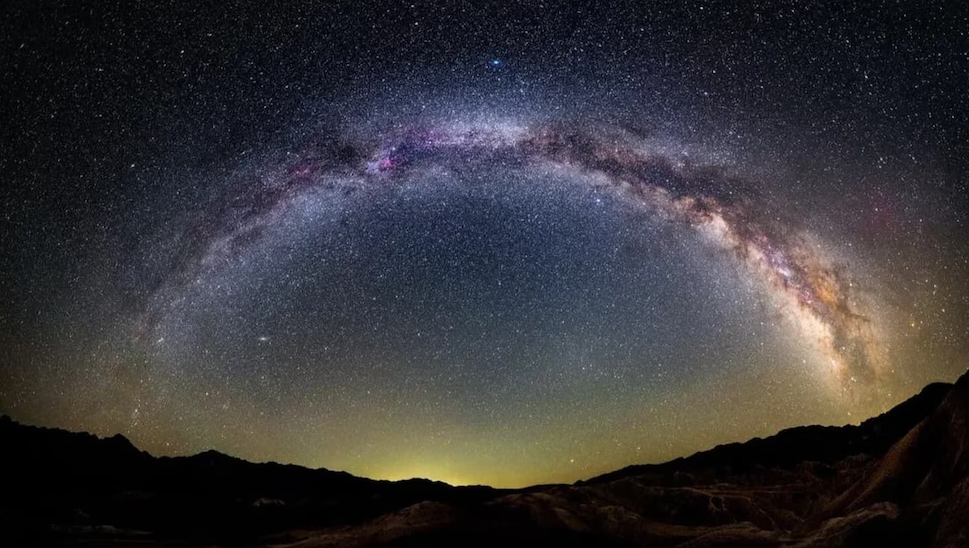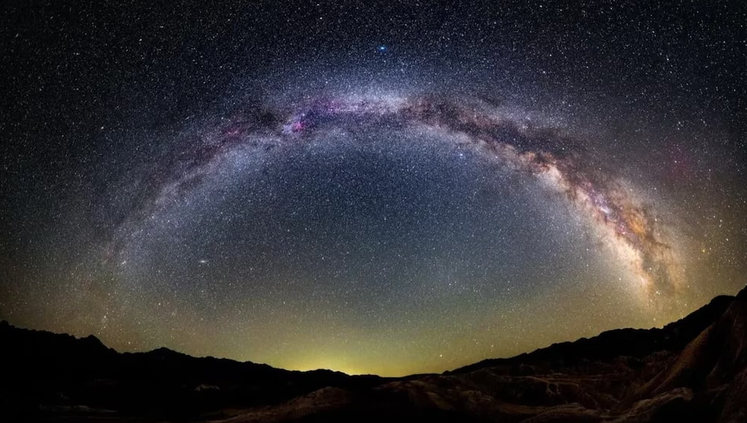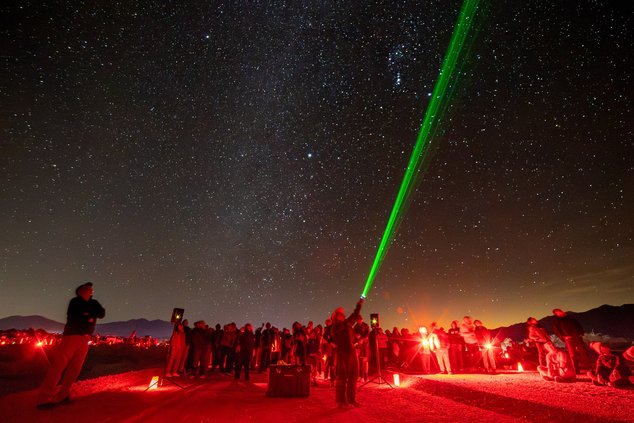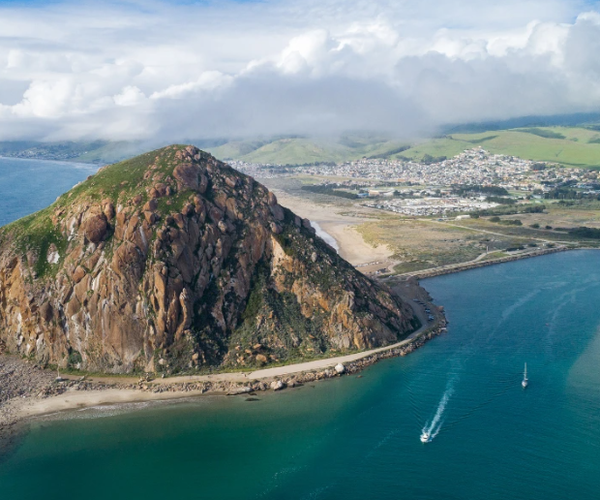STOVEPIPE WELLS — Death Valley has the most incredible night life in California.
And I make sure I partake in it whenever I make my way to what has been one of my go-to places to hike.
I try to have at least one day with a short hike so I can stay up to 1 a.m. or so to soak in the heavenly views of the night sky.
Death Valley is a certified International Dark Sky Park.
It is No. 2 on the list of the best national parks for star gazing after Great Basin National Park in Nevada.
Enterprising folks in Nevada that work to create tourism, created an Astro Tourism Route connecting the two International Dark Sky Parks.
Motorists along the route are able to travel through some of the darkest areas in the country.
As such, it offers countless opportunities for star gazing, telescope viewing and astrophotography.
Be warned, though, services are limited to the towns of Beatty, Goldfield, Tonopah, Ely and Baker.
There are very long stretches of roadway between them without cell service, restrooms, or gas stations.
Personally, I prefer to stay in one place in terms of lodging accommodations.
And as much as it might sound tempting, there is honestly more stars than you can imagine waiting for you in the skies over Death Valley.
I got my first look at the Death Valley skies on an escorted Back Roads Bicycle Touring trip in 1988.
The six-day trip included camping at the Mesquite Springs Campground the first night.
At 1,800 feet in the upper end of Death Valley proper and two miles off the Scotty Castle Road, there are 40 first-come, first-serve spaces.
It is one of the most remote campgrounds in Death Valley.
I was impressed somewhat with the sky that night.
But to be honest, I was paying more attention to interacting with the other dozen or so people in the group and more focused on getting sleep so I could tackle an alternative bicycling route up to Hell’s Gate the next day.
My interest wasn’t piqued until I returned the next year for what ended up to be an annual trip, with a gap of a year every so often, since then.
The first seven years or so it was about solo cycling first and then bringing others with me.
It was the second year where I noticed a flyer at the Stovepipe Wells resort where I stay regarding being able to view the space station every 90 minutes cross Death Valley in the heavens.
One night at dusk, I headed out to the nearby Mesquite Flat Sand Dunes — by far the most accessible in Death Valley given Highway 190 runs along the southern edge.
I hiked to the highest sand dune, set up my backpack as a pillow, and spent the next hour or so taking in the skies.
The fact Death Valley is surrounded by mountain ranges, basically devoid of development, has no trees to get in your sightline, and is not near any urban areas makes it a dark place at night.
To give you an idea of how far you can see near the ground, you can easily make out car headlights as they start descending into Death Valley at 2,289 feet some 14.6 miles from Stovepipe Wells.
I saw the space station zip across the sky that first year after just 30 minutes of settling in at the top of the sand dunes.
It was a good thing I did. Even though I wore sweats and sweatshirt, I was freezing.
Except for my first visit to Death Valley when I went in mid-March and once in July for a predawn hike 8 miles round trip to the Pamamint Dunes completed before 100 degrees rolled around at 10 a.m., my trips to Death Valley have always been in late November and early December.
While highs that time of the year will sometimes flirt with the high 80s, it drops often to 40 degrees at night. And the wind chill factor can be off the charts.
It is why Death Valley — especially with nothing to slow winds down on mountain ridges as winter approaches with temperatures dropping between three to five degrees every 1,000 feet in elevation you gain hiking — is by far the coldest place I’ve hiked, even getting pelted with snow flurries on Mt. Whitney.
On one Death Valley trip, I was headed up to 9,000 feet and ran into snow that had fallen the night before on a ridge in the Panamints.
I had three layers of outer gear on with thick winter gloves and I still felt I was one degree short of turning into an ice man.
I’m not exactly digressing.
The next year, to make sure I could weather two or so hours before midnight perched across the highest sand dune that was several hundred feet above the desert floor, I dressed as if I was going on a snow hike in January.
It allowed me to spend a good two hours soaking up what appeared to be tens of thousands of stars slowly moving across the dark skies on a moonless night.
I was able make out constellations that my sixth-grade science teacher Mr. Martyr shared with those students that attended a telescope viewing night he had each year at Glen Edwards Schools.
I almost — or let’s say I think — I also correctly recalled all the names.
Credit it to 120 minutes or so of doing nothing but gazing at the heavens lost in your own thoughts like you’ve never been lost before.
Today, without Googling, I can remember the Big Dipper, the Little Dipper, Orion and not any other names.
There are, by the way, 88 known constellations with 36 of those visible in the northern hemisphere.
Although you can star gaze practically anywhere in Death Valley near a paved road or campground, the Mesquite Flat Sand Dunes is tough to beat.
It also is just two miles from Stovepipe Wells.
Other times when I brought others with me to Death Valley, we’d drive to a fairly large turnout near Mud Canyon on the Scotty’s Castle Road, lay down a blanket and look skyward.
I figured no one else probably wanted to get into star gazing as I do.
And as enjoyable as it is sharing the experience, if you haven’t figured it out, I’m into solitude.
Death Valley does have a “dark sky festival” in February that is basically sky gazing events arranged by the rangers.
That said, since it rarely rains — or snows in Death Valley — and it is in the rain shadow of the Sierra, clouds aren’t usually an issue.
As such, any time of the year you can indulge in the best sky gazing in California that’s a seven-hour drive from the 209.
There are endless reasons to go to Death Valley.
However, its incredibly dark skies are often overlooked.
One other thing to note.
What piqued my interest to write about Death Valley sky gazing, was a press release about the top 10 national parks for dark skies.
It zeroed in on Telescope Peak at the “roof” of Death Valley.
Given its prominence and viewing shed as the tallest peak in Death Valley National Park at 11,049 feet, it undoubtedly “provides stunning high-elevation views that enhance the clarity of the night sky” as the press release states.
But it infers that Telescope Peak is where all the heavenly action is as it is “one of the most accessible places in the U.S. to experience a truly dark and breathtaking cosmos.”
Telescope Peak is a 14-mile round trip with a 3,000-foot gain and is considered strenuous.
There is a two-mile road from the Wildrose kilns that requires high clearance vehicles or four-wheel drive providing there isn’t a road washout. In addition, the Mahogany Flat campgrounds can be closed making it an 18-mile round trip.
But rest assured you can still get out of this world views near paved roads through almost the entire floor of Death Valley.
To contact Dennis Wyatt, email dwyatt@mantecabulletin.com









